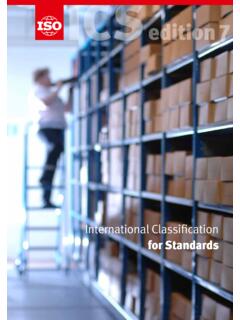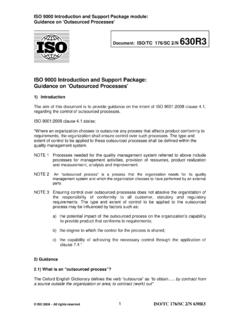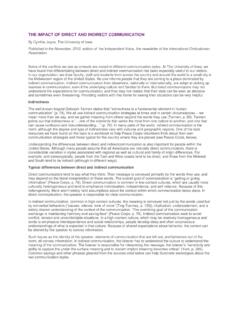Transcription of Guidance on the requirements for Documented Information …
1 ISO/TC 176/SC2/N1286 International Organization for Standardization BIBC II, Chemin de Blandonnet 8 , CP 401, 1214 Vernier, Geneva , Switzerland Tel: +41 22 749 01 11, Web: Guidance on the requirements for Documented Information of ISO 9001:2015 1 Introduction Two of the most important objectives in the revision of the ISO 9000 series of standards have been: a) to develop a simplified set of standards that will be equally applicable to small as well as medium and large organizations, and b) for the amount and detail of documentation required to be more relevant to the desired results of the organization s process activities.
2 ISO 9001:2015 Quality management systems requirements has achieved these objectives, and the purpose of this additional Guidance is to explain the intent of the new standard with specific regard to Documented Information . ISO 9001:2015 allows an organization flexibility in the way it chooses to document its quality management system (QMS). This enables each individual organization to determine the correct amount of Documented Information needed in order to demonstrate the effective planning, operation and control of its processes and the implementation and continual improvement of the effectiveness of its QMS. It is stressed that ISO 9001 requires (and always has required) a Documented quality management system , and not a system of documents.
3 2 What is Documented Information ? Definitions and references The term Documented Information was introduced as part of the common High Level Structure (HLS) and common terms for Management System Standards (MSS). The definition of Documented Information can be found in ISO 9000 clause Documented Information can be used to communicate a message, provide evidence of what was planned has actually been done, or knowledge sharing. The following are some of the main objectives of an organization s Documented Information independent of whether or not it has implemented a formal QMS; a) Communication of Information - As a tool for Information transmission and communication.
4 The type and extent of the Documented Information will depend on the nature of the organization s products and processes, the degree of formality of communication systems and the level of communication skills within the organization, and the organizational culture. ISO/TC 176/SC2/N1286 b) Evidence of conformity - Provision of evidence that what was planned has actually been done. c) Knowledge sharing d) To disseminate and preserve the organization s experiences. A typical example would be a technical specification, which can be used as a base for design and development of a new product or service. A list of commonly used terms and definitions relating to Documented Information is presented in ISO 9001:2015 Annex A.
5 It must be stressed that, according to ISO 9001:2015 clause Control of Documented Information requirements , documents may be in any form or type of medium, and the definition of document in ISO 9000:2015 clause gives the following examples: paper magnetic electronic or optical computer disc photograph master sample 3 ISO 9001:2015 Documentation requirements ISO 9001:2015 clause Quality management systems and its processes requires an organization to maintain Documented Information to the extent necessary to support the operation of processes and retain Documented Information to the extent necessary to have confident that the processes are being carried out as planned.
6 Clause General explains that the quality management system documentation shall include: a) Documented Information required by this International standard; b) Documented Information determined by the organization as being necessary for the effectiveness of the quality management system The note after this Clause make it clear that the extent of the QMS Documented Information can differ from one organization to another due to the: a) size of organization and its type of activities, processes, products and services; b) complexity of processes and their interactions, c) competence of persons. All the Documented Information that forms part of the QMS has to be controlled in accordance with clause Documented Information .
7 4 Guidance on Clause of ISO 9001:2015 The following comments are intended to assist users of ISO 9001:2015 in understanding the intent of the general Documented Information requirements of the International Standard. Documented Information can refer to: ISO/TC 176/SC2/N1286 a) Documented Information needed to be maintained by the organization for the purposes of establishing a QMS (high level transversal documents). These include: The scope of the quality management system (clause ). Documented Information necessary to support the operation of processes (clause ). The quality policy (clause 5.). The quality objectives (clause ).
8 This Documented Information is subject to the requirements of clause b) Documented Information maintained by the organization for the purpose of communicating the Information necessary for the organization to operate (low level, specific documents). See Although ISO 9001:2015 does not specifically requires any of them, examples of documents that can add value to a QMS may include: Organization charts Process maps, process flow charts and/or process descriptions Procedures Work and/or test instructions Specifications Documents containing internal communications Production schedules Approved supplier lists Test and inspection plans Quality plans Quality manuals Strategic plans Forms Where it exists, all such Documented Information , is also subject to the requirements clause c) Documented Information needed to be retained by the organization for the purpose of providing evidence of result achieved (records).
9 These include: Documented Information to the extent necessary to have confidence that the processes are being carried out as planned (clause ). Evidence of fitness for purpose of monitoring and measuring resources (clause ). Evidence of the basis used for calibration of the monitoring and measurement resources (when no international or national standards exist) (clause ). Evidence of competence of person(s) doing work under the control of the organization that affects the performance and effectiveness of the QMS (clause ). Results of the review and new requirements for the products and services (clause ). Records needed to demonstrate that design and development requirements have been met (clause ) Records on design and development inputs (clause ).
10 Records of the activities of design and development controls (clause ). Records of design and development outputs (clause ). Design and development changes, including the results of the review and the authorization of the changes and necessary actions (clause ). Records of the evaluation, selection, monitoring of performance and re evaluation of external providers and any and actions arising from these activities (clause ) ISO/TC 176/SC2/N1286 Evidence of the unique identification of the outputs when traceability is a requirement (clause ). Records of property of the customer or external provider that is lost, damaged or otherwise found to be unsuitable for use and of its communication to the owner (clause ).











